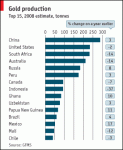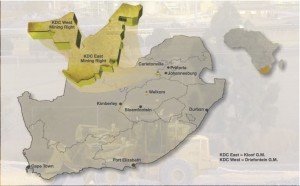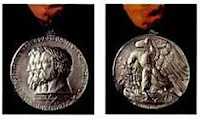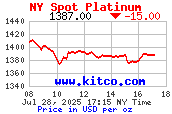Sep 4, 2012 | bullion, gold, markets, news, platinum
Unrest continues in the mining communites of South Africa as the National Union of Mineworkers (NUM) ups their efforts to calm the rank and file. The NUM, an ally of the ruling African Nationa Congress (ANC), have rejected calls to exploit the termoil for the benefit of the workers.
The strike has virtually shut down the Lonmin mine that supplies 19-percent of the platinum to the world.
Gold One is reporting that the wildcat strike that caused four injuries yesterday was open on Tuesday. However, the nearby Aurora mine also owned by Gold One remains closed.
Worker unrest is happening during the campaign for control of the ANC. Former youth leader Julius Malema has been travelling to the effected mines blaming President Jacob Zuma for anti-worker policies and accusing the NUM of partnering with the ANC not in the benefit of the workers.
Malema was expelled from the ANC for “ill discipline.”
Lonmin and Gold Fields stock, already depressed prior to current events, are down even further on the United States and South African markets. Trading on Gold Fields stock in South Africa has been halted on market trading rules.
Currently, gold and platinum prices are trading based on current economic conditions with futures looking at December delivery of these metals. An analyst interviewed for this story said that if the unrest continues, the futures prices will not be affected until late January or early February deliveries are traded—which could begin later in September.
The Coin Collectors Blog will continue to monitor the international reporting and market reaction for their effect on metals prices. Stay tuned!
Sep 3, 2012 | gold, markets, news, platinum

An unidentified mine worker sits on a rock at the Lonmin mine near Rustenburg.
Unrest continues as police used tear gas and rubber bullets to turn back a group of about 60 mineworkers at the Gold One mine at Modder East near Johannesburg who was blocking the roads and throwing rocks at vehicles trying to enter the mine area. Four miners were reported hospitalized by police actions.
 Fear of national mining disruption continues as strikes spread to gold mines in South Africa. Local business leaders are afraid that the strikes will hurt South African mines in the long term causing a ripple effect in the economy. South Africa is the world’s third leading producer of gold behind China and the United States.
Fear of national mining disruption continues as strikes spread to gold mines in South Africa. Local business leaders are afraid that the strikes will hurt South African mines in the long term causing a ripple effect in the economy. South Africa is the world’s third leading producer of gold behind China and the United States.
Market analysts have been reporting that since they see South Africa as an “investor-unfriendly” country that most investments are in exchange-traded funds (ETF) that helps balance the risks.
Gold futures for December delivery rose $9.60, or 0.6-percent, to $1,697.20 an ounce in electronic trading today. London Gold Fixing PM price was $1,691.50, up $5.50 from the AM fix or 0.3-percent. U.S. markets were closed on Monday for the Labor Day holiday.
AP Photo/Themba Hadebe of striker courtesy of IOL Business Report.
Gold Production graph courtesy of ZeroHedge.
Sep 2, 2012 | bullion, gold, news, platinum

Mourners carry the casket of Andries Motlapula Ntsenyeho, one of the 34 striking platinum mineworkers shot dead at Lonmin’s Marikana mine, at his home town of Sasolburg in South Africa’s Free State province on Sept 1, 2012.
“The murder charge against the current 270 suspects, which was provisional anyway, will be formally withdrawn provisionally in court on their next court appearance,” acting national director of prosecutions Nomgcobo Jibo told a news conference.
The move to drop the charges occurred as funerals are being held for those killed during the strike.
Unrest continues in Marikana and other South African mining towns as police are being investigated after admitting to firing on striking mineworkers. Some of those officers are on administrative leave but no arrests have been made. This has put pressure on current president Jacob Zuma, who is seeking re-election this December.
Lonmin is the world’s third largest producer of platinum accounting for 12-percent of the world’s production. Lonmin’s primary market is the use of platinum in catalytic converters in cars.
The Marikana mine has been closed since the massacre and was set to re-open after this weekend’s funerals. There has been no report as to whether the wildcat sympathy strike at the KDC East mine owned by Gold Fields will allow that mine to open.
Weak demand has pushed down the market price of platinum leaving mining operators slimmer margins as costs have been rising. The price of platinum has risen only 8.3-percent ($117.00) since August 16, but only up 7.8-percent in 2012.
Gold closed at $1648.50 in London on Friday, down $17 from Thursday (0.7-percent). The price of gold closed at $1691.60 on the New York market, rising after Federal Reserve Chairman Ben Bernanke hinted that the Fed could introduce a “fresh, unconventional U.S. monetary policy stimulus will be implemented at some point.”
There have been no reports from market analysts as to how the South African unrest will effect metals prices.
Image courtesy of Reuters via The Sunday Times of Singapore
Sep 1, 2012 | gold, news, platinum

Location of the Gold Field’s Kloof-Driefontein Complex (KDC)
According to Gold Fields, KDC East produces 1,660 ounces of gold per day.
The Association of Mineworkers and Construction Union (AMCU) has said that they are not involved with the strike and claims the strike was caused by a dispute between National Union of Mineworkers (NUM) branches. AMCU is working with the South African government over the shooting deaths of 34 and wounding 78 striking minders by police at the Lonmin Platinum mine on August 16. The South African National Prosecuting Authority charged 270 miners with murder and attempted murder.

Striking platinum mineworkers gather for a report back on negotiations at Lonmin’s Marikana mine in South Africa’s North West Province, August 29, 2012.
NUM workers have been on strike since August 10, primarily in a dispute with their own union claiming that the union leaders are more interested in politics than the needs of the miners.
Lonmin reports that a 6.6 average attendance in all shafts of the mine following the shootings. The mine is located in the city of Rustenburg, northwest of Johannesburg.
London Gold Fixing closed at $1,648.50, down $9.25 from the morning price. Platinum closed at $1,517.00 up $9.00 from the morning price. Prices were posted prior to the statement issued by Gold Fields. London markets are open on September 3 while the United States markets will be closed for Labor Day.
Map of KDC courtesy of Gold Fields, Ltd.
Image of striking workers courtesy of Reuters/Mike Hutchings
Oct 3, 2010 | Eagles, gold, palladium, platinum, silver, US Mint
In a rare swift move by the House of Representatives, H.R. 6166, American Eagle Palladium Bullion Coin Act of 2010, was introduced, discharged from the House Committee on Financial Services, considered on the floor, and passed without objection. With its passage in the House, the bill was Engrossed and sent to the Senate for consideration.
In the Senate, the bill was read twice and referred to the Committee on Banking, Housing, and Urban Affairs. Congress has adjourned for the election season.
H.R. 6166 was introduced by Rep. Denny Rehberg (R-MT), the representative at-large from Montana. Montana is home of the Stillwater Mining Company, (NYSE: SWC) the only producer of palladium in the United States. Stillwater also owns platinum mines that supplies the U.S. Mint with platinum for American Eagle Bullion coins. With this bill, Rehberg adds his name to a long line of congressmen who have introduced bills to protect their state’s mining interests by using the U.S. Mint as a primary purchaser.
In the world of metal investing, palladium is behind gold, silver, and platinum in demand. Palladium is not as popular in the United States as it is in other countries. Palladium sells better than silver in Canada and Europe. It is rarer than gold, but a little more abundant than platinum but has the silky look of platinum while being almost as ductile as silver. Artists in Europe and Asia are beginning to use palladium instead of platinum for their higher-end designs.
Since the price of palladium is less than the price of gold and platinum, it is possible that investors could consider palladium as part of a diverse portfolio. Those who believe in “end of the world” scenarios will not be interested because the secondary market is not as strong as it is for gold.

 The bill requires that “the obverse shall bear a high-relief likeness of the ‘Winged Liberty’ design used on the obverse of the so-called ‘Mercury dime’” making it yet another bullion coins using a design from the early 20th century. For the reverse, the law says that it “shall bear a high-relief version of the reverse design of the 1907 American Institute of Architects medal.” Both the Mercury Dime and 1907 AIA medal were design by Adolph A. Weinman, whose Walking Liberty design is used on the American Silver Eagle coin.
The bill requires that “the obverse shall bear a high-relief likeness of the ‘Winged Liberty’ design used on the obverse of the so-called ‘Mercury dime’” making it yet another bullion coins using a design from the early 20th century. For the reverse, the law says that it “shall bear a high-relief version of the reverse design of the 1907 American Institute of Architects medal.” Both the Mercury Dime and 1907 AIA medal were design by Adolph A. Weinman, whose Walking Liberty design is used on the American Silver Eagle coin.
In other words, congress saying that it does not trust the U.S. Mint to create a design suitable for this coin. While some might have an issue with the design of recent coins, it would be nice to unleash the creativity of the U.S. Mint’s artists and allow them to make a design to represent Liberty. Maybe if the artists were less constrained, they can use their talents.
Another provision of the bill is that aside from using palladium from U.S. sources, it allows the U.S. Mint to purchase palladium from other sources. The bill also makes a distinction between proof and bullion coins allowing the U.S. Mint consider minting proofs to meet collector demand… or not depending on whether there is a demand and a supply to meet the demand. In other words, it will be up to the government lawyers to figure out what is meant by the wording in the bill!
If the bill passes the Senate and signed by the President, palladium bullion coins will not be issued until 2012 because it is too late in the year for the U.S. Mint to plan to issue this coin.
1938 Mercury Dime image is owned by the author.
Image of the 1907 AIA Medal copied from Architecture: celebrating the past, designing the future by Nancy B. Solomon.
Oct 8, 2008 | gold, platinum, RCM, silver, US Mint
Showing that the management of the US Mint does not understand how to manage a specialized manufacturing facility, it was reported that the Mint is not going to try to maintain the supply to meet the demand for precious metals. In a letter to authorized dealers, the Mint blames the fluctuating market and high demand for this decision.
For the rest of the year, the Mint will continue to strike gold and platinum coins until supplies of blanks are depleted. The supply of 24-karat Gold Buffaloes have been depleted. Silver and one-ounce gold American Eagles will continue to be available as they can be struck.
Those wanting to purchase gold may want to consider previous years or Canada Gold Maple Leafs. It is being reported that the Royal Canadian Mint continues to strike gold but has been having problems keeping up with the demand. Alex Reeves, a spokesperson with the Royal Canadian Mint, said, “[Distributors] would like more gold than we can produce but we’re supplying the best we can. Look at that as good news. We’re able to keep producing gold while the U.S. Mint has to throw up their hands and say, ‘we’re out.’ ”
Fasten your seat belts, it’s going to be a bumpy ride!
Sep 15, 2008 | Eagles, gold, platinum, silver, US Mint
When I woke up this morning, I found that Lehman Brothers filed for Chapter 11 Bankruptcy protection on Sunday. Merrill Lynch, another venerable Wall Street institution, is being purchased by Bank of America. Insurance giant AIG is asking the Federal Reserve for a bridge loan to weather its own fiscal issues. As the Dow Jones Industrial Average index drops 300 points after the markets open, it is not surprising that there are worries about the fundamentals of the economy.
Those of us in numismatics, we watch the prices of precious metals for indication as to how our market is going. In recent weeks, gold, silver, and platinum have been falling to levels not seen since early 2007. As I write this, gold is up $11.80 to $775.50 per ounce (1.5-percent) while silver is up only 20-cents and platinum is down $38.00.
The general rule of thumb is that when there are problem in the capital markets, investors try to convert their cash to precious metals. While gold is the most popular investment, the relatively stable prices and average trading volumes suggest that investors are not running away.
For the collector, this means that collectibles tied to the prices of precious metals should not move much. Even though the U.S. Mint has not changed its prices during this declining market, those using American Eagle and 24-karat Gold Buffaloes as investments can find coins from previous years at lower prices.
If you are collecting rare coins, the PCGS3000 Index (a market basket price of 3,000 rare coins) shows that prices are up $4.65 for the day (0.01-percent). The PCGS3000 index has trended upward since November 2007.
As a collector and not an investor, I will take the advice of Dave Harper and wait to see what happens to the market. The currents are much to rough for a collector to jump in head first!
Dec 14, 2007 | coins, Eagles, platinum, US Mint
If you are looking for a real nice present, you may want to consider buying the 2007 10th Anniversary Platinum American Eagle set. The set consists of two half-ounce platinum proof coins. One is a regular style proof where the elements are frosted and the fields are mirrored. The other coin is what the US Mint is calling an “Enhanced Reverse Proof” because it is not an exact reverse proof—only parts of the elements are reversed to enhance the design. Both coins carry the “W” mint mark.
The Mint will produce no more than 30,000 sets and will restrict the sale of one coin per household for the first seven days of sale with a projected shipping date of December 31, 2007. The set sells for $1,949.95 for one ounce of platinum in a special box. Platinum closed at $1,475 (per ounce) on the New York spot market.
Oct 15, 2007 | coins, gold, platinum, US Mint
When I decided to take a week off, I did not think that there would be much news in the numismatic community. I knew that the US Mint would issue the 28-coin 2007 Mint Set with a satin finish. I figured that would be all of the news from the Mint until the release of the James Madison Dollar. But it seems that precious metals prices have had an effect on Mint products.
 As the dollar weakens, investors are running to precious metals to protect their assets. This is driving up the prices for gold and platinum. The increased interested gold caused its spot price to reach $711.40 on September 12. Because the margin decreased, the Mint suspended sales of American Eagle gold coins on September 13.
As the dollar weakens, investors are running to precious metals to protect their assets. This is driving up the prices for gold and platinum. The increased interested gold caused its spot price to reach $711.40 on September 12. Because the margin decreased, the Mint suspended sales of American Eagle gold coins on September 13.
 Platinum has also been surging. As of the market close on Friday, October 5, platinum closed at $1365—up over $300 this year— as gold closed at $741.30. When the markets opened on Monday, the Mint suspended sales of the platinum American Eagles and American Buffalo gold proof coins. The next day, bulk sales to dealers were halted. Only the silver and platinum proof American Eagles are still available.
Platinum has also been surging. As of the market close on Friday, October 5, platinum closed at $1365—up over $300 this year— as gold closed at $741.30. When the markets opened on Monday, the Mint suspended sales of the platinum American Eagles and American Buffalo gold proof coins. The next day, bulk sales to dealers were halted. Only the silver and platinum proof American Eagles are still available.
Dave Harper of Numismatic News speculates that the Mint acts when the threshold between the cost of the metals and the spot prices are within $100 of the Mint’s sales price. While he has no evidence of this, it is a plausible theory based on recent events as all bullion sales ceased when gold and platinum spot prices were within $100 of the Mint’s sales price.
Before the Mint can reprice these coins, they are required to publish the new prices in The Federal Register. Nothing has been announced. Market volatility may make this more difficult for the Mint than expected. It could take the Mint until the end of the month to set new prices to allow the market to settle.






![[Most Recent Quotes from www.kitco.com]](http://www.kitconet.com/images/sp_en_6.gif)




